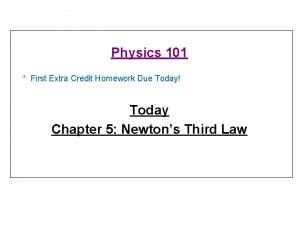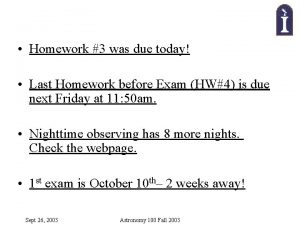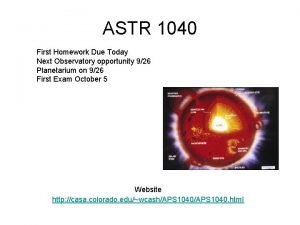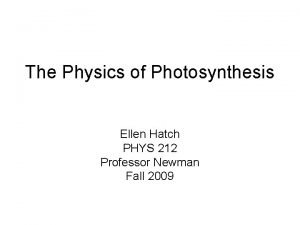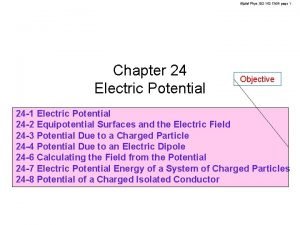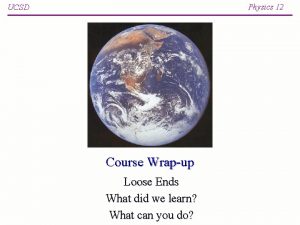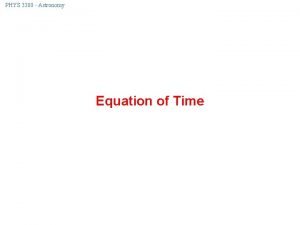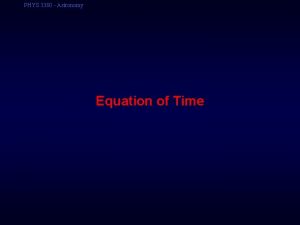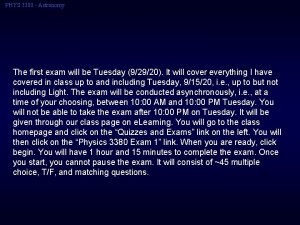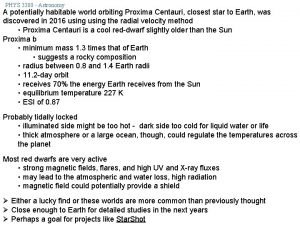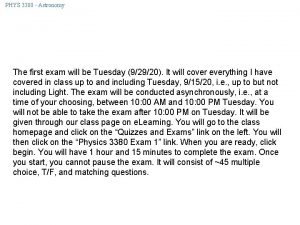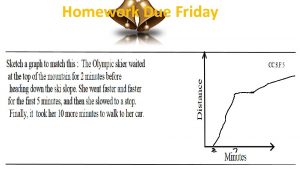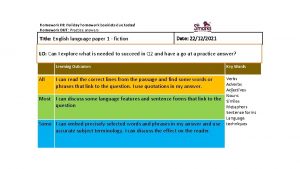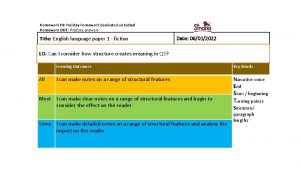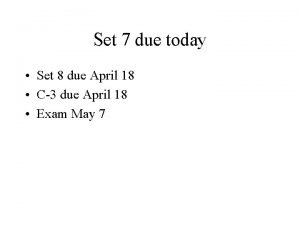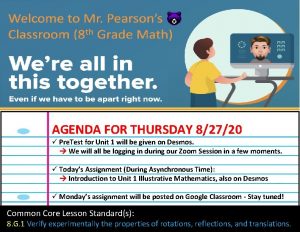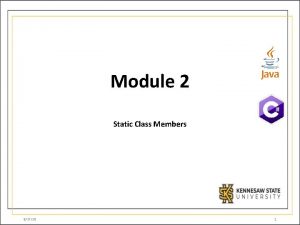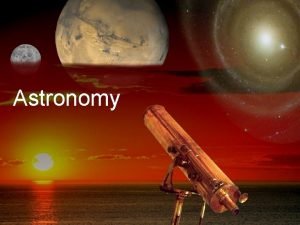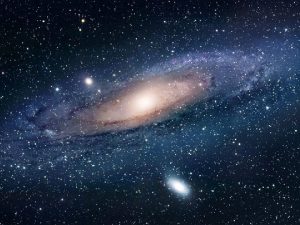PHYS 3380 Astronomy Homework Set 2 82720 Due
































- Slides: 32

PHYS 3380 - Astronomy Homework Set #2 8/27/20 Due 9/3/20 Chapter 3 Review Questions 4, 7, 19 Problems 3, 11, 13, 15 Using the small angle formula, calculate the angular size of Venus as viewed from Earth at inferior conjunction.

PHYS 3380 - Astronomy Sun’s Altitude vs Latitude and Season Animation

PHYS 3380 - Astronomy Why are the seasons more extreme in the Northern hemisphere?

PHYS 3380 - Astronomy 1. Most of Earth’s land mass in in the Northern Hemisphere. Water takes longer to heat or cool than soil or rock (water has a higher heat capacity). The water temperature remains relatively constant, thereby moderating the climate. 2. Earth is slightly farther from the sun during northern summer solsitce moves slower in its orbit so summer/winter is 2 - 3 days longer/shorter. This effect is more important then the slightly more intense sunlight due to Earth being closer/farther away.

PHYS 3380 - Astronomy Five Major Circles of Latitude 1. The Arctic Circle (66. 5 degrees N) 2. Tropic of Cancer (23. 5 degrees N) 3. The Equator 4. The Tropic Capricorn (23. 5 degrees S) 5. The Antarctic Circle (66. 5 degrees S) What is special about these latitude circles?

PHYS 3380 - Astronomy Five Major Circles of Latitude The Arctic and Antarctic Circles - One day a year the sun shines all day and one day a year it doesn’t shine at all. Tropic of Cancer (Capricorn) - The sun is never directly overhead at higher latitudes.

PHYS 3380 - Astronomy Precession (a) A spinning top slowly wobbles, or precesses, more slowly than it spins. (b) The Earth's axis also precesses. Each precession cycle takes about 26, 000 years. Note that the axis tilt remains about the same throughout the cycle, but changing orientation of the axis means that Polaris is only a temporary North Star.

PHYS 3380 - Astronomy Precession Movie

PHYS 3380 - Astronomy Gravitational Attraction The Sun’s gravity (and the Moon’s to a lesser degree) tugs on the Earth trying to straighten out its rotational axis. However, like any rotating object, the Earth tends to keep spinning around the same axis. The result is that gravity succeeds only in making the axis precess.

PHYS 3380 - Astronomy 26, 000 yrs Climate Changes 41, 000 yrs 100, 000 yrs Changes in Earth’s orbit and orientation cause cyclic changes in climate - ice ages. Mildest period about 5, 000 years ago - headed for another ice age.

PHYS 3380 - Astronomy Milankovitch Theory Variations in Earth's orbit, the resulting changes in solar energy flux at high latitude, and the observed glacial cycles. Milankovitch Theory - precession of equinoxes, variations in tilt of Earth's axis (obliquity) and changes in eccentricity of the Earth's orbit responsible for observed 100 kyr cycle in ice ages by varying amount of sunlight received by the Earth particularly noticeable in high northern latitude summer.

PHYS 3380 - Astronomy Aspects of an Inferior Planet. Various configuration of an inferior planet are defined as shown here. Any planet whose orbit is smaller than Earth’s orbit is called a “inferior” planet. Mercury and Venus are the only inferior planets.

PHYS 3380 - Astronomy As viewed from Earth, Mercury can be seen only near times of greatest eastern or western elongation. • At greatest western elongation (when the planet is farthest west of the sun in the sky), Mercury rises about 1 1/2 hours before sunrise. • At greatest eastern elongation (when the planet is farthest east of the sun in the sky), Mercury sets about 1 1/2 hours after sunset. Mercury

PHYS 3380 - Astronomy Venus is at maximum elongation at 47° - at maximum brilliancy at 39º combination of amount of sunlit Venus visible and distance from Earth brightness of reflected light

PHYS 3380 - Astronomy Venus and Mercury can sometimes be seen in the west at sunset - “evening stars” or in the east at sunrise - morning “stars”.

PHYS 3380 - Astronomy Planetary Transits Mercury’s orbit tilted 7° to ecliptic plane - Crosses ecliptic plane only at the two nodes - Transit of Mercury across Sun’s disk possible only when Mercury passes through inferior conjunction near nodes - around May 8 and Nov 10 - occurs every 3 - 13 years. Next on November 11, 2019.

PHYS 3380 - Astronomy Mercury Transit of the Sun

PHYS 3380 - Astronomy Images taken at UTD of Mercury transit of November, 2006

PHYS 3380 - Astronomy Venus Transits Venus orbit tilted 3. 4º to the ecliptic Transits of Venus only occur in pairs about 8 years apart every ~120 years. Transits occurred in 2004 and 2012 (June) Edmund Halley one of few to observe first transit in 1677 after invention of telescope - called upon future astronomers to observe subsequent transits. On his first voyage, Captain Cook traveled to Tahiti to observe transit of 1769 in an attempt to estimate the distance from the Earth to the Sun using triangulation and the parallax effect. Measurements not very accurate: - intense sunlight filtering through Venus' atmosphere fuzzed the edge of the disk and decreased the precision with which Cook could time the transit - his measurements disagreed with those of ship's astronomer Charles Green, who observed the transit beside Cook, by as much as 42 seconds.

PHYS 3380 - Astronomy - Cook and Green also observed the "black drop effect. " When Venus is near the limb of the sun - the critical moment for transit timing - the black of space beyond the Sun's limb seems to reach in and touch the planet - made it hard to say just when the transit began or ended. - a problem for observers elsewhere - observations of Venus' 1769 transit from 76 points around the globe not precise enough to set the scale of the solar system. Astronomers didn't manage that until the 19 th century when they used photography to record the next pair of transits.

PHYS 3380 - Astronomy Venus Transit of the Sun

PHYS 3380 - Astronomy Aspects of a Superior Planet. Various configurations of superior planet are defined as shown here. Any planet whose orbit is larger than Earth’s orbit is called a “superior” planet.

PHYS 3380 - Astronomy

PHYS 3380 - Astronomy Lunar Phases Moon’s appearance and rise and set times change with the cycle of the lunar phases The sun illuminates one side (half) of the moon - appearance varies with side of moon facing the Earth - the angle between the sun-Earth line and the Earth-moon line.

PHYS 3380 - Astronomy Phases of the Moon Animation

PHYS 3380 - Astronomy Lunar Phase Terminology Phases of the Moon’s 29. 5 day cycle new crescent first quarter gibbous waxing full gibbous last quarter crescent waning

PHYS 3380 - Astronomy Lunar Phases

PHYS 3380 - Astronomy New Moon First Quarter Full Moon

PHYS 3380 - Astronomy Full Moon Third Quarter New Moon

PHYS 3380 - Astronomy Moon Rise and Set Animation

PHYS 3380 - Astronomy What’s wrong with this moon (at night)?

PHYS 3380 - Astronomy Earthshine The dark portion of the lunar face is not totally dark - you can see the outline of the full face of the Moon even when the Moon is not full - in particular the crescent phase. Because the crescent phase is nearly a new moon as seen from Earth, the Earth is nearly full as viewed from the moon. The light of Earth illuminates the night moonscape - just as the full moon illuminates the Earth landscape. Because Earth is much larger than the Moon, the full earth is much bigger and brighter in the lunar sky than the full moon is in Earth's sky. This faint light illuminating the “dark” portion of the Moon's face is often called the ashen light or earthshine.
 Learning astronomy by doing astronomy activity 1 answers
Learning astronomy by doing astronomy activity 1 answers Learning astronomy by doing astronomy activity 1 answers
Learning astronomy by doing astronomy activity 1 answers Learning astronomy by doing astronomy answers
Learning astronomy by doing astronomy answers Total set awareness set consideration set
Total set awareness set consideration set Training set validation set test set
Training set validation set test set Jack prelutsky homework oh homework
Jack prelutsky homework oh homework Homework oh homework i hate you you stink
Homework oh homework i hate you you stink Homework oh homework i hate you you stink
Homework oh homework i hate you you stink Homework oh homework i hate you you stink
Homework oh homework i hate you you stink Parts of a poem
Parts of a poem Homework i love you poem
Homework i love you poem Homework is due on friday
Homework is due on friday Homework due today
Homework due today Homework due today
Homework due today Homework is due on friday
Homework is due on friday Homework is due
Homework is due Homework due today
Homework due today Homework due today
Homework due today Homework due today
Homework due today Folk culture and popular culture venn diagram
Folk culture and popular culture venn diagram Homework due tomorrow
Homework due tomorrow Astr
Astr Nascita di sparta
Nascita di sparta Due piccole sfere identiche sono sospese
Due piccole sfere identiche sono sospese Il rombo ha tutti i lati uguali
Il rombo ha tutti i lati uguali Substantive vs procedural due process
Substantive vs procedural due process Phys 212 equation sheet
Phys 212 equation sheet Aljalal phys 102
Aljalal phys 102 Phys courses ucsd
Phys courses ucsd Phys 244
Phys 244 Phys root word
Phys root word Phys courses ucsd
Phys courses ucsd Phys 241 purdue
Phys 241 purdue
















